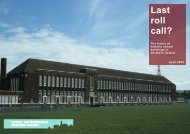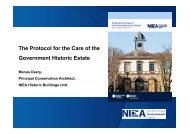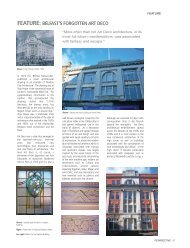Directory of Traditional Building Skills - Mourne Heritage Trust
Directory of Traditional Building Skills - Mourne Heritage Trust
Directory of Traditional Building Skills - Mourne Heritage Trust
Create successful ePaper yourself
Turn your PDF publications into a flip-book with our unique Google optimized e-Paper software.
7 GLASS AND GLAZINGWindow design developed with technical advances in the production <strong>of</strong> glass. Early blownglass was replaced by spun glass in the eighteenth century and is still to be found in manyhistoric buildings. It is characterised by irregularities, bubbles and defects. Modern sheet orplate glass, developed by the nineteenth century is largely free from such defects and so is nomatch for historic glass. Spun glass is becomingly increasingly valuable and period glass isnow available; for vernacular buildings agricultural glass may be used.Nineteenth century float glass allowed larger and more regular panes and simplified glazingpatterns. Inexpensive stained glass became available with a range <strong>of</strong> etched and patternedglasses and was widely used in hall doors, stairs and landings. Stained glass repair is best leftto specialist craftsmen. The lead that separates the glass is prone to distortion, sagging andexpansion buckling, especially in the larger frames. Sometimes the only solution is completere-leading although it may be possible to sandwich an old, fragile window between sheets <strong>of</strong>plain glass. Conservators retain stocks <strong>of</strong> old glass for repairs.Modern safety regulations can demand that toughened or laminated glass is used in doors orlow windows where a change <strong>of</strong> use or major renovations require <strong>Building</strong> Control Approval.This may be too thick for the old mouldings and its greenish colour changes the character.Secondary glazing or internal balustrades may be alternative solutions which preserve thecharacter <strong>of</strong> the original.Historically, glass was invariably putty glazed and modern timber slips are inappropriate. Forsound insulation internal, secondary glazing is most effective and although inappropriate forfine interiors it does retain the integrity <strong>of</strong> the original windows.See also Section 5 Joinery p. 92Appendix 1: Further reading – p. 149106











